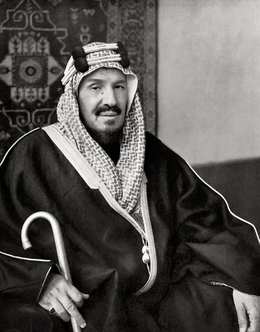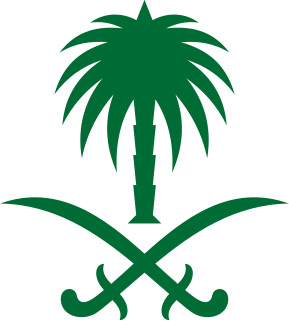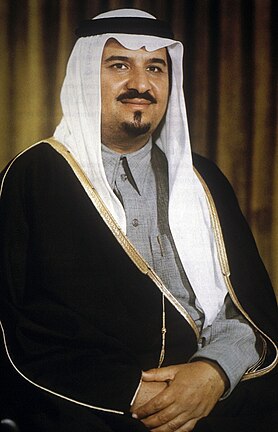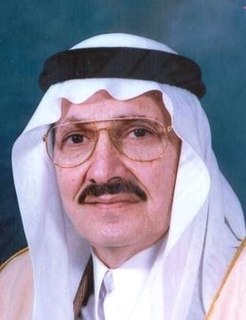
Riyadh is the capital of Saudi Arabia and the largest city on the Arabian Peninsula. Located in the center of the an-Nafud desert, on the eastern part of the Najd plateau, the city sits at an average of 600 meters (2,000 ft) above sea level, and receives around 5 million tourists each year, making it the forty-ninth most visited city in the world and the 6th in the Middle East. Riyadh had a population of 7.6 million people in 2019, making it the most-populous city in Saudi Arabia, 3rd most populous in the Middle East, and 38th most populous in Asia.

Abdulaziz bin Abdul Rahman Al Saud, known in the West as Ibn Saud, was an Arab tribal leader and statesman who founded Saudi Arabia, the third Saudi state. He was King of Saudi Arabia from 23 September 1932 to his death in 1953. He had ruled parts of the kingdom since 1902, having previously been Emir, Sultan, and King of Nejd, and King of Hejaz.

Saud bin Abdulaziz Al Saud was the King of Saudi Arabia from 9 November 1953 to 2 November 1964. He was the second son of King Abdulaziz, the founder of modern Saudi Arabia, and the first of Abdulaziz's six sons who were kings.

The House of Saud is the ruling royal family of Saudi Arabia. It is composed of the descendants of Muhammad bin Saud, founder of the Emirate of Diriyah, known as the First Saudi state (1744–1818), and his brothers, though the ruling faction of the family is primarily led by the descendants of Abdulaziz bin Abdul Rahman, the modern founder of Saudi Arabia. The most influential position of the royal family is the King of Saudi Arabia, an absolute monarch. The family in total is estimated to comprise some 15,000 members; however, the majority of power, influence and wealth is possessed by a group of about 2,000 of them. Some estimates of the royal family's wealth measure their net worth at $1.4 trillion, this figure includes the market capitalization of Saudi Aramco, the state oil & gas company, and its vast assets in fossil fuel reserves.

Sultan bin Abdulaziz Al Saud, called Sultan the Good in Saudi Arabia, was the Saudi defense minister from 1963 to 2011 and the crown prince of Saudi Arabia from 2005 to 2011.
The Saudi Arabian National Guard or SANG, also known as the "White Army", is one of the three major branches of the military forces of the Kingdom of Saudi Arabia.

Khalid bin Faisal Al Saud is a Saudi royal who is the governor of Makkah Province in Saudi Arabia, in office from 2007 to 2013 and again since 2015. He was the Saudi minister of education from 2013 to 2015. He was also the governor of Asir Province from 1971 to 2007. He served as the adviser to King Salman.

Mutaib bin Abdullah Al Saud is a Saudi prince and military officer who served as Saudi Arabia's minister of the National Guard from 2013 to 2017. Previously he was commander of the National Guard from 2010 to 2013. He was arrested on 4 November 2017 along with other Saudi princes including Prince Al Waleed. He was stripped of his position as minister on the same day. He was released on 28 November 2017 after agreeing an "acceptable settlement" with authorities of more than $1 billion (£750m).

Haʼil is a city in north-western Saudi Arabia. It is the capital and largest city of Ha'il Region, with a population of about 605,930 (2018)

Saud Al Kabeer bin Abdulaziz Al Saud was a grandson of Saud bin Faisal bin Turki and a cousin and important supporter of King Abdulaziz, founder of Saudi Arabia. Prince Saud was one of the most known Najdi people. Through his marriages he was the brother-in-law, and later he became the son-in-law, of King Abdulaziz. Saud was married for 45 years to King Abdulaziz's eldest sister Noura bint Abdul Rahman, and after her death in 1950 he married the King's daughter Princess Hessa.

Muhammad bin Abdul Rahman Al Saud was an Arabian soldier and politician who played a role in the conquests of his half-brother Abdulaziz that led to the formation of the Kingdom of Saudi Arabia. He was the son of Abdul Rahman bin Faisal, Emir of Nejd, and Sara bint Jiluwi bin Turki. Muhammad was an early supporter of his half-brother, King Abdulaziz, but they had a falling-out after both attempted to place their sons in line for kingship. This conflict may have led to the death of Muhammad's son Khalid in 1938. Muhammad later became a virtual non-entity in Saudi politics.
Bandar bin Abdulaziz Al Saud was the tenth son of King Abdulaziz of Saudi Arabia. At the time of his death, he was the eldest surviving member of the ruling branch of the House of Saud.
Badr bin Abdulaziz Al Saud was a long-term deputy commander of the Saudi National Guard and a senior member of the Saudi royal family.

Talal bin Abdulaziz Al Saud, formerly also called The Red Prince, was a Saudi Arabian politician, dissident, businessman, and philanthropist. A member of the House of Saud, he was notable for his liberal stance, striving for a national Constitution, the full rule of law and equality before the law. He was also the leader of Free Princes Movement in the 1960s.
Hussa bint Ahmed Al Sudairi was one of the many spouses and cousins of King Abdulaziz of Saudi Arabia, with whom she had seven sons and four daughters. Her sons included two future Saudi kings, Fahd and Salman, as well as Sultan bin Abdulaziz and Nayef bin Abdulaziz, who both later served as crown prince. Her sons with Abdulaziz are commonly known as the Sudairi Seven.

Abdullah bin Abdulaziz Al Saud was a Saudi Arabian politician and military commander who ruled as King of Saudi Arabia from 1 August 2005 until his death in 2015. He was the tenth son of King Abdulaziz, the founder of Saudi Arabia, and the fifth of Abdulaziz's six sons who were kings.
Mishaal bin Saud Al Saud is a Saudi prince and was the governor of the Najran Province from 1997 to 2008.
The following is a Gregorian timeline of the history for the city of Riyadh, Saudi Arabia.

The crown prince of Saudi Arabia is the second most important position in Saudi Arabia, second to the King, and is his designated successor. Currently, the Crown Prince assumes power with the approval of the Allegiance Council after he is nominated by the King. This system was introduced to the country during the reign of King Abdullah. In the absence of the King, an order is issued to have the Crown Prince manage the affairs of the state until the King's return.

Abdulaziz (1875–1953), the founder and first king of Saudi Arabia, was very young when he first married. However his wife died shortly after their marriage. Abdulaziz remarried at eighteen and his firstborn child was Turki. He had 45 sons of whom 36 survived to adulthood and had children of their own. He also had many daughters. He is thought to have had 22 wives.














